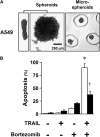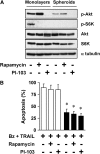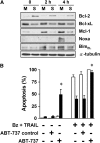Bcl-2 family proteins contribute to apoptotic resistance in lung cancer multicellular spheroids
- PMID: 19097992
- PMCID: PMC2701959
- DOI: 10.1165/rcmb.2008-0320OC
Bcl-2 family proteins contribute to apoptotic resistance in lung cancer multicellular spheroids
Abstract
Combinatorial therapies using the proteasome inhibitor, bortezomib, have been found to induce synergistic apoptosis in cancer cells grown as monolayers; however, three-dimensional spheroid culture may be a better model for the multicellular resistance found in solid tumors, such as lung cancer. We tested the combinatorial apoptotic strategy of using bortezomib together with TNF-related apoptosis-inducing ligand (TRAIL), both in monolayers and in spheroids of A549 lung cancer cells. Indeed, bortezomib plus TRAIL induced synergistic apoptosis in A549 cells grown as monolayers, but had little effect on A549 cells grown as three-dimensional multicellular spheroids. The acquired resistance of spheroids was not due to a limitation of diffusion, to survival pathways, such as NF-kappaB or PI3K/Akt/mTOR, or to the up-regulation of FLIP(S) (Fas-associated death domain-like IL-1 beta-converting enzyme inhibitory protein, short). We then investigated a role for the Bcl-2 family of anti- and proapoptotic proteins. When cells formed spheroids, antiapoptotic Bcl-2 increased, whereas antiapoptotic Mcl-1 decreased. ABT-737, a small molecule that inhibits Bcl-2, but not Mcl-1, abolished the multicellular resistance of A549 spheroids to bortezomib plus TRAIL. In another lung cancer cell line, H1299, acquisition of multicellular resistance in spheroids was also accompanied by an increase in Bcl-2 and decrease in Mcl-1. In H1299 spheroids compared with those of A549, however, Mcl-1 remained higher, and Mcl-1 knockdown was more effective than ABT-737 in removing multicellular resistance. Our study suggests that the balance of Bcl-2 family proteins contributes to the acquired multicellular resistance of spheroids, and suggests a possible target for improving the response of lung cancer to bortezomib therapies.
Figures







Comment in
-
Rounding up apoptosis resistance targets in lung cancer.Am J Respir Cell Mol Biol. 2009 Jul;41(1):7-8. doi: 10.1165/rcmb.2009-0002ED. Am J Respir Cell Mol Biol. 2009. PMID: 19525385 No abstract available.
Similar articles
-
Rounding up apoptosis resistance targets in lung cancer.Am J Respir Cell Mol Biol. 2009 Jul;41(1):7-8. doi: 10.1165/rcmb.2009-0002ED. Am J Respir Cell Mol Biol. 2009. PMID: 19525385 No abstract available.
-
ABT-737 induces expression of the death receptor 5 and sensitizes human cancer cells to TRAIL-induced apoptosis.J Biol Chem. 2008 Sep 5;283(36):25003-13. doi: 10.1074/jbc.M802511200. Epub 2008 Jul 3. J Biol Chem. 2008. PMID: 18599488 Free PMC article.
-
Mammalian target of rapamycin contributes to the acquired apoptotic resistance of human mesothelioma multicellular spheroids.J Biol Chem. 2008 May 9;283(19):13021-30. doi: 10.1074/jbc.M709698200. Epub 2008 Mar 13. J Biol Chem. 2008. PMID: 18339627 Free PMC article.
-
Rational combination of dual PI3K/mTOR blockade and Bcl-2/-xL inhibition in AML.Physiol Genomics. 2014 Jul 1;46(13):448-56. doi: 10.1152/physiolgenomics.00173.2013. Epub 2014 May 13. Physiol Genomics. 2014. PMID: 24824212 Free PMC article. Review.
-
[Apoptosis resistance in malignant tumors: novel apoptosis-based therapeutic approaches].Pathologe. 2009 Dec;30 Suppl 2:113-6. doi: 10.1007/s00292-009-1181-9. Pathologe. 2009. PMID: 19756623 Review. German.
Cited by
-
Octa-arginine-modified pegylated liposomal doxorubicin: an effective treatment strategy for non-small cell lung cancer.Cancer Lett. 2013 Jul 10;335(1):191-200. doi: 10.1016/j.canlet.2013.02.020. Epub 2013 Feb 16. Cancer Lett. 2013. PMID: 23419527 Free PMC article.
-
Improved Anticancer Effect of Recombinant Protein izTRAIL Combined with Sorafenib and Peptide iRGD.Int J Mol Sci. 2019 Jan 27;20(3):525. doi: 10.3390/ijms20030525. Int J Mol Sci. 2019. PMID: 30691192 Free PMC article.
-
A bibenzyl from Dendrobium ellipsophyllum induces apoptosis in human lung cancer cells.J Nat Med. 2018 Jun;72(3):615-625. doi: 10.1007/s11418-018-1186-x. Epub 2018 Feb 27. J Nat Med. 2018. PMID: 29488156
-
MicroRNA 133B targets pro-survival molecules MCL-1 and BCL2L2 in lung cancer.Biochem Biophys Res Commun. 2009 Oct 23;388(3):483-9. doi: 10.1016/j.bbrc.2009.07.143. Epub 2009 Aug 3. Biochem Biophys Res Commun. 2009. PMID: 19654003 Free PMC article.
-
Three-dimensional (3D) cell culture: a valuable step in advancing treatments for human hepatocellular carcinoma.Cancer Cell Int. 2022 Jul 30;22(1):243. doi: 10.1186/s12935-022-02662-3. Cancer Cell Int. 2022. PMID: 35908054 Free PMC article. Review.
References
-
- Bremer E, van Dam G, Kroesen BJ, de Leij L, Helfrich W. Targeted induction of apoptosis for cancer therapy: current progress and prospects. Trends Mol Med 2006;12:382–393. - PubMed
-
- Broaddus VC, Dansen TB, Abayasiriwardana KS, Wilson SM, Finch AJ, Swigart LB, Hunt AE, Evan GI. Bid mediates apoptotic synergy between tumor necrosis factor–related apoptosis–inducing ligand (TRAIL) and DNA damage. J Biol Chem 2005;280:12486–12493. - PubMed
-
- Lowe SW, Cepero E, Evan GI. Intrinsic tumour suppression. Nature 2004;432:307–315. - PubMed
-
- Milligan SA, Nopajaroonsri C. Inhibition of NF-kappa B with proteasome inhibitors enhances apoptosis in human lung adenocarcinoma cells in vitro. Anticancer Res 2001;21:39–44. - PubMed
-
- An J, Sun Y, Fisher M, Rettig MB. Maximal apoptosis of renal cell carcinoma by the proteasome inhibitor bortezomib is nuclear factor-kappaB dependent. Mol Cancer Ther 2004;3:727–736. - PubMed
Publication types
MeSH terms
Substances
Grants and funding
LinkOut - more resources
Full Text Sources
Other Literature Sources
Medical
Research Materials
Miscellaneous

